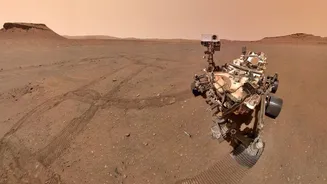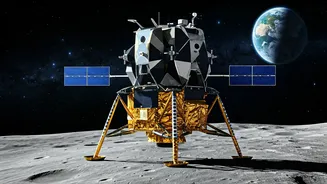Initial Intrigue: Dark Streaks
For years, the appearance of dark streaks across the Martian surface during warmer seasons has puzzled scientists. These streaks, known as recurring slope
lineae (RSL), sparked considerable curiosity, and liquid water was hypothesized as their origin. The intriguing nature of RSL, coupled with the potential for liquid water, fuelled the excitement of possibly finding areas that might be conducive to supporting some form of life. This led to multiple missions and studies to understand the dynamics and the composition of these seasonal dark features. But the initial hopes for discovering water started fading as the evidence was reviewed, and a new picture began to emerge.
AI's Analytical Approach
The latest research employed AI-assisted analysis to re-examine the data on the Martian streaks. This sophisticated methodology allowed researchers to sift through extensive datasets, encompassing images and spectral readings. The use of artificial intelligence proved critical in identifying subtle patterns and correlations that might have escaped manual detection. This approach empowered researchers to consider a more complex hypothesis, testing it against the available evidence. The AI models assessed various factors, including the terrain's characteristics and the seasonal changes linked to the streaks, leading to a profound understanding of what caused these phenomena to occur. The technology provided a new lens through which to observe and interpret the Martian environment, which was crucial to the study's conclusions.
Dust Avalanche Revelation
The AI's analysis unveiled a startling revelation: the dark streaks are not created by liquid water. Instead, the team discovered they are formed by dry dust avalanches. These events happen when dust slides down the slopes of the Martian terrain, leaving dark trails that are visible due to the contrast with the surrounding landscape. The avalanches appear to be triggered by seasonal changes, possibly temperature fluctuations or the sublimation of ice, causing the surface to destabilize. This interpretation fundamentally alters existing theories about the Martian environment, which means the planet is less watery than once presumed. The study provides a compelling demonstration of AI's power to redefine our perspectives on planetary science.
Implications and Understanding
The discovery about the Martian dark streaks has far-reaching implications, most notably concerning the planet's water resources. It implies that Mars might be drier than previously estimated, influencing how scientists will approach future searches for signs of life. Also, the findings offer new insights into Martian climate processes, revealing how dust movements influence the planet's visual aspects. Moreover, the study demonstrates the importance of advanced technologies, such as AI, in interpreting and analysing complex datasets to provide us with fresh insights into the cosmos. It encourages a reappraisal of past observations and informs upcoming missions to Mars and other celestial bodies. The implications help scientists to rethink some of the fundamental premises in the study of Martian geology.
Future Research Pathways
This research opens up multiple avenues for further investigation. Researchers can now focus on understanding the triggers and mechanisms that cause dust avalanches on Mars. This involves analyzing atmospheric conditions, terrain features, and seasonal dynamics. Future missions may aim to study the dust streaks directly, taking soil samples and analyzing their composition to gather further details. These investigations would offer more data on the geological processes at play on Mars, deepening our grasp of the planet’s activity. The study suggests that our knowledge of Mars is still evolving, with new discoveries poised to alter our understanding and guide future expeditions. Continued focus on these questions promises to reveal still more about the enigmatic Red Planet.












